More Maps of the American Nations
Post updated, 6/10/14. See below!
As we saw previously (see My Most Read Posts), my post Maps of the American Nations is the single most popular post so far here on my blog. Americans all over are supremely interested in both their origins and the reasons for the cultural quirks of the different American regions.
Fundamentally, the reason for these regional differences is the inherited traits of the people who comprise the various ethnonational regions. In this post, I will further elucidate the existence and pervasiveness of these differences, as well as make the case for their ultimately genetic underpinnings. As well, I will tackle the persistent myth of “assimilation” that is often thrown about in discussion of American regional differences and other human differences.
The roots of these regional differences across the continent trace themselves to the people who settled them. This begins with the founding groups, whose typically explosive population growth seeded each area with a single large ethnic group, establishing the cultural foundation. This was then supplanted by demographic input of subsequent immigrants. Indeed, the character of each region – especially outside the current “Dixie” alliance – deviates from the character of each area’s founding stock thanks the contributions from the many immigrant groups that have come in.
Many believe that the eventual fate of immigrants is to “assimilate.” But, as has been discussed here, assimilation largely does not occur. Indeed, if it did, why would the different American nations be recognizable as separate ethno-cultural-political areas today? To the extent that any assimilation occurs, it is only in the most superficial ways, such as language, dress, or adoption of technology. Immigrant groups generally do not conform in less content-laden aspects, such as economic achievement/performance, criminality, or overall political/social/religious views. On top of this, intermixing can give the false impression of assimilation, as this causes the behavior of “native” and immigrant groups to converge over time. Later in this post, I will address this matter at length.
First, let us look again at the American nations as described by Colin Woodard:
Previously we saw that we could demarcate the various nations with voting habits:
For more on the nature of each “nation”, see my previous post Flags of the American Nations and/or this piece by Woodard on his book with respect to the Tea Party. This political split is not new. Historically, each nation voted much as a bloc, although the current blue state/red-state coalitions don’t go that far back, and the alliances between different nations have shifted quite a few times in the country’s history (see the historic presidential election result maps results here).
We see a rather pronounced split, with Yankeedom (Greater New England), the Midlands, the Left Coast, New Netherland, and “El Norte” on one side, and the Deep South, Greater Appalachia, and the Far (Interior) West on the other team. These dueling alliances sit at the center of the present political battles in the United States, as we saw in my previous post Mapping the Road to American Disunion.
However, we also see some distinct deep “blue” regions across the Old South and Southwest. These underscore the importance of taking into account the racial divides across the country:
…as seen in my previous post Colors and Lights. Of course, the racial division contributes considerably to the “cultural” divide – but politically, across the nation, the non-White vote tends to be pretty uniform, as noted by Audacious Epigone. Politically, the main divide exists among the country’s White population, as seen here (from here):
As we see, the Tidewater, the historic seat of the Cavalier Lowland South, leans towards team blue mostly because of the large Black population there (however, some of the Tidewater is also being colonized by more liberal-leaning Whites spilling out from the Washington D.C. metro area). In addition to voting habits, language/dialect, average IQ, criminality, military zeal, and attitudes towards cannabis (as seen previously), the American Nations make themselves visible in other rather significant ways.
Some of these differences can be quite surprising, such as reaction to adverse weather (in terms of the amount of snow needed to cancel school), as seen on my post Snow Nations:
The American nations are also discernible in Americans’ enthusiasm for major league sports teams, here baseball (from here):
Basketball (favorite NBA team, from here):
Football (favorite NFL team, from here):
For football, an older map from CommonCensus Sports Map Project produced a map of each region’s favorite NFL team based on internet votes, which it claims is “highly inaccurate”, yet, interestingly, conforms quite well to the American nations’ borders:
In addition to sports preferences, the American nations make themselves evident in another, much more serious way: attitudes towards crime and punishment. Particularly, the implementation of the death penalty shows a profound regional variation (from Pew):
Consistent with the more aggressive attitudes of the clannish Borderlanders of Greater Appalachia & the Far West and the Cavaliers of the Tidewater & the Deep South, the bulk of the country’s executions are concentrated in these nations. A look at the execution rate per capita equalizes the seeming rarity of capital punishment in the (sparsely populated) Far West (from here):

Indeed, as this makes clear, capital punishment is effectively banned in the Yankee states. The high number of executions across some parts of the Tidewater and the Deep South does reflect a somewhat higher crime rate, but that’s not the whole story:
 Some states, such as Tidewater/Appalachian Virginia and Texas, while having higher than average crime rates, also have much higher execution rates. These states clearly have a greater willingness to resort to the death penalty, indicative of their decidedly martial heritage.
Some states, such as Tidewater/Appalachian Virginia and Texas, while having higher than average crime rates, also have much higher execution rates. These states clearly have a greater willingness to resort to the death penalty, indicative of their decidedly martial heritage.
Edit, 6/10/14:
[**To compliment the above maps, I’ve tracked down some interesting maps on guns in America:
First, gun ownership rates by state (from here):

I so far haven’t been able to track down ownerships per county, but I have found a rough proxy, number of gun shops and dealers per capita by county (from patchwork nation):
 The Far West, with its vast emptiness and independent spirit, shows prominently. Greater Appalachia, and to a lesser extent, the Deep South and Tidewater, also come in strong. The northern areas of Yankeedom also are prominent. Here in Maine, for example, there are plenty of guns. However, they are primarily used for hunting, which is quite popular here (I frequently hear gun shots from my home). The embrace of gun varies quite a bit across the nations, but the reasons for having them vary considerably more. In Yankeedom, they are primarily for hunting. Across the Deep South, they are kept primarily for protection.
The Far West, with its vast emptiness and independent spirit, shows prominently. Greater Appalachia, and to a lesser extent, the Deep South and Tidewater, also come in strong. The northern areas of Yankeedom also are prominent. Here in Maine, for example, there are plenty of guns. However, they are primarily used for hunting, which is quite popular here (I frequently hear gun shots from my home). The embrace of gun varies quite a bit across the nations, but the reasons for having them vary considerably more. In Yankeedom, they are primarily for hunting. Across the Deep South, they are kept primarily for protection.
In keeping with the different attitudes of the different American nations towards punishment, we see that this is reflected in the legality and utilization of school corporal punishment:


As seen previously in my post Another Map of the American Nations: School Corporal Punishment. (Red = allowed. Blue = not allowed). The red state alliance of Greater Appalachia, the Deep South, and the Far West are where this is practiced. However, as seen on the map, the states with the highest Black populations have the highest rates of physical discipline. But, as Audacious Epigone has established, Blacks are the most supportive of corporal punishment of all American racial/ethnic groups.
As well as punishment, the American nations differ fundamentally in their attitudes towards sharing and taking care of one another. As per HBD Chick’s theory, and fitting the clannishness of the respective founding groups (see A Tentative Ranking of the Clannishness of the “Founding Fathers”), the various American nations are predictably divided about Obama’s health care law:
 As seen in my previous post, Healthcare and the American Nations, the various nations have responded to aspects of the law depending on their clannish characteristics. The more universalist Puritans and Quakers – along with their Scandinavian and German co-settlers of Yankeedom and the Midlands – have generally trended toward acceptance. By contrast, the clannish Scots-Irish and Cavaliers of Dixie alliance (as well as the clannish Mexicans of El Norte) have responded in a more self-interested manner. None of these nations are terribly interested in contributing to the system, but El Norte and Greater Appalachia correctly see themselves as being net recipients, so are happy to accept the policies that allow themselves to benefit. The Tidewater and the Deep South, on the other hand, with their large Black populations (seen by the Cavalier Whites as being “the other“), want no part of the policy.
As seen in my previous post, Healthcare and the American Nations, the various nations have responded to aspects of the law depending on their clannish characteristics. The more universalist Puritans and Quakers – along with their Scandinavian and German co-settlers of Yankeedom and the Midlands – have generally trended toward acceptance. By contrast, the clannish Scots-Irish and Cavaliers of Dixie alliance (as well as the clannish Mexicans of El Norte) have responded in a more self-interested manner. None of these nations are terribly interested in contributing to the system, but El Norte and Greater Appalachia correctly see themselves as being net recipients, so are happy to accept the policies that allow themselves to benefit. The Tidewater and the Deep South, on the other hand, with their large Black populations (seen by the Cavalier Whites as being “the other“), want no part of the policy.
In addition, the attitude towards social issues is decided split across the American nations, as seen here (from Wikipedia) in attitudes towards same-sex marriage (itself reflective of the general attitude towards homosexuality and non-“traditional” sexuality in general – Edit, 6/10/14: updated map to one current as of this date):
As seen previously in my post Gay Germ Fallout?, Yankeedom, the Left Coast, New Netherland, and to a lesser extent, the Midlands and El Norte have embraced same-sex marriage, while the other nations ardently reject it.
Edit, 6/10/14: [**Indeed, I managed to find a decent metric of support for gay marriage by county, as derived from data from Facebook:
 This is the fraction of Facebook users in each county that changed their profile image to the red equal sign in support of same-sex marriage, with the American nations borders overlain. Judging from this, support is strongest across Yankeedom, the Left Coast, and the Midlands (the German settled areas of Greater Appalachia straddling the Midlands are evident here, as well). On the opposing side, the Dixie nations, the Tidewater, Greater Appalachia, and the Deep South stand ardently against. The Far West appears a bit mixed; the more liberal areas, like those in Colorado, appear more supportive.**]
This is the fraction of Facebook users in each county that changed their profile image to the red equal sign in support of same-sex marriage, with the American nations borders overlain. Judging from this, support is strongest across Yankeedom, the Left Coast, and the Midlands (the German settled areas of Greater Appalachia straddling the Midlands are evident here, as well). On the opposing side, the Dixie nations, the Tidewater, Greater Appalachia, and the Deep South stand ardently against. The Far West appears a bit mixed; the more liberal areas, like those in Colorado, appear more supportive.**]
 Other social issues follow this pattern, such as attitude towards that perennial hot-button issue: abortion (from here).
Other social issues follow this pattern, such as attitude towards that perennial hot-button issue: abortion (from here).
In short, the “Culture Wars” are just the latest round in the ongoing cold civil war between the states, which is really a struggle between the various nations.
Edit, 6/10/14:
[**I’ve managed to track down a map that shows more local data on attitudes towards abortion, an “isarithmic” map, based on ZIP code level data of a survey 30,000 Americans, from here. This gives results similar to county-level data, however, this map is also a function of population density (that is, the white vs. black shows population density, and the teal vs. purple, the local attitude over abortion), smoothed across the region. I have laid the American nations borders over top:
It is apparent support for abortion is strong in “New Netherland,” The Left Coast, Yankeedom (especially in the east), and the eastern section of the Midlands. El Norte is also supportive. Opposition is fierce across Greater Appalachia, the Tidewater, and the Deep South. Interestingly, the Far West is surprisingly supportive. This may be reflective of the strong tradition of equality between the sexes that has existed there, which I discuss below.**]
And of course, the “American” nations are hardly confined to the United States, but continue on, generally quite uninterrupted, into our neighbor to the north, Canada:
…as seen previously in my post Nations of Canada. Indeed, perhaps Woodard’s book should have been titled North American Nations. These national divisions color Canadian politics much as they do in the U.S., but perhaps less bitterly so (from Wikipedia):
 In both Canada and the U.S., while the founding groups laid the foundation for the character of each nation, it is wrong to think that the genetic stock of these populations are the dominant force underlying today’s socio-political-cultural divisions. To give the most poignant example of this, Dutch genes are not the driving force behind the modern character of “New Netherland” (i.e., the Greater New York City metro area) – indeed, the Dutch weren’t a numerical majority in the colony to begin with. Rather, other genetic stock, from the subsequent migrants, continues to drive these divisions.
In both Canada and the U.S., while the founding groups laid the foundation for the character of each nation, it is wrong to think that the genetic stock of these populations are the dominant force underlying today’s socio-political-cultural divisions. To give the most poignant example of this, Dutch genes are not the driving force behind the modern character of “New Netherland” (i.e., the Greater New York City metro area) – indeed, the Dutch weren’t a numerical majority in the colony to begin with. Rather, other genetic stock, from the subsequent migrants, continues to drive these divisions.
This is illustrated by this now fairly well-known map:
Immigration to the country, especially during the industrial boom of the late 19th and early 20th centuries and since 1965 has served to transform the country. In many of these areas, especially across the north of the country, the immigrants have overwhelmed the colonial stock and have, as such, transformed the country. I will return to this point when I discuss assimilation, however, I first wanted to take a look at a matter that has complicated interpretation of this map.
A key problem with this map is that it was based on self-reported ancestry, and that entailed a certain degree of untrustworthiness, as Greg Cochran once discussed:
When responding to the Census, more than five million Americans claim to be of Dutch descent. And they mostly are, at least a little. Now you might wonder how they compare with the Dutch back in the Netherlands: you might wonder about the relative academic or economic success of these two groups, which presumably have a common ancestry. But you would be wrong to do so. You would be comparing apples and House of Orangemen.
…
Why, if there was any justice, Henry Harpending would own a fine farm on Manhattan Island right now. Of course, Henry isn’t all that Dutch. His surname is. He comes from an area of New York State that really did have some Dutch settlement. The thing is, white Protestants in this country have been intermarrying rather freely for several hundred years: it is rare to find someone in that category whose ancestors all come from one ethnicity.
…
Most of the people who self-identify as Dutch-Americans are mostly something else. Why? Sometimes a family tradition, or a surname, but more than anything else, fashion.
Fashions change. For example, the fraction of Americans who report English ancestry has dropped drastically since 1980 – so much that so that you would have to wonder about secret death camps if you took it seriously. But it’s fashion. I looked at the census numbers for my home county, and then looked at the phone book: Census result was 20% English ancestry, real number was more like 80%. Of course this means that people in the US claiming a particular ethnicity can not only have limited ancestry from that group, but be oddly unrepresentative as well.
This complicates the process of inferring the ethnic composition of the country. It seems that only genetic evidence could establish the reality. Fortunately, now we have some.
Ancestry.com has used DNA from their customers (N > 250,000) to estimate the national ancestry of Americans. They have produced a series of interactive maps on their site (white paper on their methodology here). Here I will display these maps side-by-side with maps of self-reported ancestry as gathered from the U.S. Census (from Wikipedia):
- “Swedish” ancestry
- “Norwegian” ancestry
- “Danish” ancestry
The genetic results for Scandinavian ancestry appears to line up very well with self-reported results, apparently even capturing the Danish converts in Mormon country.
- “Italian” ancestry
- “Greek” ancestry
Genetic results also confirm Italian and Greek self-reported ancestry, finding both being primarily confined to the Northeast.
- “Polish” ancestry
Reported Eastern European ancestry (primarily Polish) also appears to be about right.
- “Irish” ancestry
“Irish” ancestry is where we see our first disconnect between self-reported ancestry and the genetic data. We see a strong pulse in eastern New England. But the rest of the country lines up less well with the genetic data. Over at race/history/evolution notes, through surname analysis, “n/a” has found that self-reported Irish ancestry across the U.S. is likely inflated, although it’s probably accurate in Massachusetts and nearby.
- “English” ancestry
- “American” ancestry
And here is British ancestry. This is includes ancestry from England, Scotland, and Wales. Naturally, as per David Hackett Fischers Albion’s Seed, people from Great Britain are a major constituent in all 50 states. As Cochran noted, however, this is also the most “under-acknowledged” ancestry, perhaps considered too “plain” to even report by many. Indeed, across Greater Appalachia and much of the Tidewater and Deep South, this is relegated instead to a concocted “American” ancestry. However, the descendants of the Puritans – and their western offshoots, the Mormons – are apparently most apt to acknowledge their English heritage, as we see two pulses of British ancestry in the genetic data in northern New England proper and again in the Far West, centered on Mormon country. No doubt, especially in New England, the British component also includes Scottish Highlander ancestry hailing from the Canadian Maritimes.
 A distinct relative “hole” in British ancestry is apparent in northern/western Yankeedom is evident however, as the other groups who have established themselves there have formed more of an ethnic majority over the Puritan settlers from eastern New England.
A distinct relative “hole” in British ancestry is apparent in northern/western Yankeedom is evident however, as the other groups who have established themselves there have formed more of an ethnic majority over the Puritan settlers from eastern New England.
The areas of high reported Finnish ancestry appear to be confirmed genetically.
- “German” ancestry
- “French” ancestry
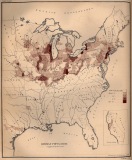 And here we have genetic data from “Europe West”, which primarily captures ancestry from Germany and France. The genetic data would seem to support the heavy German component in the country, especially along the Midlands and western Yankeedom. Some of the most heavily German states, such as Iowa, Nebraska, and Kansas are heavily evident here.
And here we have genetic data from “Europe West”, which primarily captures ancestry from Germany and France. The genetic data would seem to support the heavy German component in the country, especially along the Midlands and western Yankeedom. Some of the most heavily German states, such as Iowa, Nebraska, and Kansas are heavily evident here.
As well, the French pulse across New England is also evident. This French pulse also brings me to another interesting point when we look at ancestry and the American nations.
As we’ve seen previously in my post, HBD is Life and Death, the health outcomes of many American regions can be correlated to ethnic ancestry. Most poignant among these were the many pathologies that plague the Scots-Irish, evident by how Greater Appalachia (and often the Far West, and sometimes the Left Coast) tended to stick out in many of these maps:
- Remaining dry counties in the U.S.
- Meth labs
- Smoking Rates by county
- Stoke Death Rates, Whites
As well, there are these maps. First, of suicide rates (age-adjusted, by 100,000 population, 2000-2006, from the CDC), where Greater Appalachia and the Far West pop out:
 Edit, 6/10/14: [**Thanks to the CDC’s interactive system, I have managed to compile maps of suicide rates by race:
Edit, 6/10/14: [**Thanks to the CDC’s interactive system, I have managed to compile maps of suicide rates by race:
The Far West especially jumps out with an exceptionally high suicide rate. Greater Appalachia also stands out, and the Tidewater and Deep South are evident as well. However, an interesting modification emerges with you separate firearm from non-firearm suicides:
When non-firearm suicides are considered, suddenly Yankeedom, the Midlands, and the Left Coast become more strongly represented. The Far West, however, features a high rate in both cases. When firearm suicides are examined, Greater Appalachia, the Tidewater, and the Deep South become more visible. Apparently the strong culture of guns in these nations boosts the success of those seeking to take their own lives. **]
Prescription drug overdoses (in good part opiates, from here):
Here again, the areas with high Scots-Irish ancestry – Greater Appalachia itself, the Far West, and often the Left Coast – pop out.
Edit, 6/10/14: [** Also, see this rather interesting map of traffic fatalities per county (all races; non-Hispanic White alone is little different): 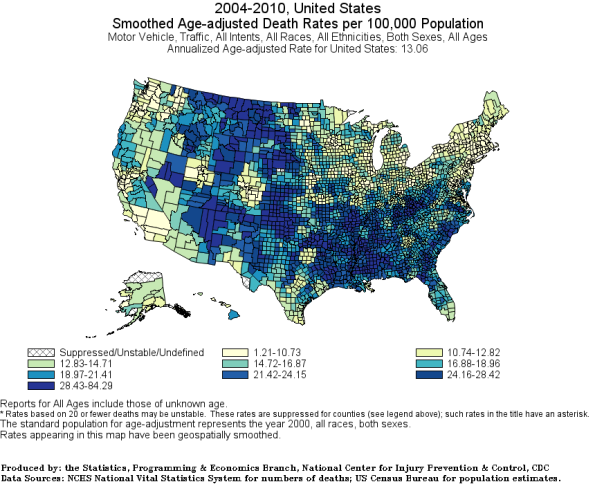
Greater Appalachia, the Tidewater, the Deep South, and the Far West pop out, again. Perhaps this speaks to a preponderance of wreckless drivers in these nations. Note the interesting bubble in Mormon country, however. **]
As well, this map of poverty across America (largely a function of average IQ, from Wikipedia):
As per the racial distribution map, the counties with lower average IQ populations (i.e., Blacks, Hispanics, and Native Americans) are evident. However, in addition to these groups, here again, we see that largely White Greater Appalachia is comparatively impoverished.
However, interestingly, also joining the Scots-Irish in poorer outcomes are the French Canadians, particularly those found in the northern areas of Yankeedom. Maine, which is heavily New French in descent, consistently does poorly compared to the other Yankee states. Indeed, economic historian Gregory Clark in his surname analysis (see my earlier post The Son Becomes The Father) found that the French Canadians in the United States exhibited unusually low upward mobility and were underrepresented among elite professions, quite like Blacks and Native Americans.

Maine governor Paul LePage (source)
I found this quite interesting. The average IQ of France is essentially identical to that of Britain, so that’s not the issue. And even better, according to the PISA test results (from 2000-2012), Quebec does as well as the rest of Canada, typically scoring close to the national average. So the problem isn’t an initial deficit among the colonial New French. Indeed, as Peter Frost noted, some of the French Canadians may have underwent a period of intense selection for intelligence. That their descendants in the United States would then have a lower average IQ than other White groups would seem strange. I decided to take a look at French Canadian migration to the U.S.
As it turns out, during the heyday of Euro immigration to the U.S. (the industrial boom of the late 19th and early 20th centuries), over 900,000 French Canadians came to the United States. In good part, this was largely demographic spillover, as the French Canadian population underwent explosive growth and New France was beginning to fill. Many of these excess New French ventured to the factories jobs in the U.S., most across northern Yankeedom. Indeed, during the 100 years from 1840-1940, Quebec sent an average of 7% of its population per decade to the United States.
And, quite unlike other Euro immigrants to the States, the New French could in effect skip right across the border to reach their new homes. Most every migration event involves some sort of sorting process, and it appears in this migration the sorting process was pretty intense. Indeed, not only was access to travel comparatively easier compared to venturing across the Atlantic, the opportunities that awaited them in the New England factories “frequently required no formal skills or education and often would employ children and women.” The bulk of the emigrants to the U.S. were poor rural dwellers, (although a few middle class types did go to make a living offering their services to the migrants who left before them). The New French elite characterized the migrants thusly:
The clerical elite frequently misidentified the reasons for emigration laying the blame on the laziness of the emigrant or the extravagant desire for luxury of his wife. They were portrayed as weak people, incapable of effort or sacrifice, self-centred and inconsiderate of others.
While this source portrays this as propaganda meant to downplay and/or discourage the exodus, there may have been some element of truth to it. Perhaps the New French emigration to the U.S. was overly composed of the bottom rungs of Quebec and Acadian society.
In addition, overall goal among the emigrants was to eventually return to Canada, and a considerable fraction did so, albeit often only temporarily. It would appear likely, then, that the migration process involved two selective elements for the less able: those least successful in Canada in the first place were most likely to leave, and those unable to quickly make something of themselves in their new home were the least likely to be able to permanently return. Contrast this with other migrations events from greater distances, which tended to select for those quite above the bottom in both the initial migration and eventual retention in the States.
The “cultural” impact of the migrants, and by that, I mean the genetic impact, is strong and continues to be felt to this day. For example, see these of the impact of the beer-loving German migrants (from here) Edit, 6/10/14, updated the map with one showing frequencies:
Note correspondence to the German distribution above.
Indeed, Steve Sailer recently commented on the decided more German character of the U.S. vis-a-vis Britain:
I had lunch yesterday with a donor who is an Englishman who has lived all over the world. He brought up the topic of how a lot of aspects of American life strike him as more German than English, such as American newspapers, which have traditionally aspired to be serious, informative, and responsible, while British newspapers like being outrageous and fun.He then went off to meet with some German friends and writes:Good brainstorm over a beer with my buddies on the Germanness of America, some of which I already mentioned:
1. TV advertising (slapstick, not subtle)
2. The Army (are there more German generals than German politicians in the US — which states does army recruit from?)
Pershing, Eisenhower, Schwartzkopf
3. Attitude to self improvement
The German poet Rilke’s mantra “You must change your life” caught on a lot faster in America, especially California, than Britain. For example, my Swiss German paternal grandfather was a health food nut who moved to Southern California 85 years ago to grow his own food in his yard.
4. Easy to scare (see Hollywood), lack of natural scepticism
5. Taking things serious (the brit needs to be seen not to be trying)
6. Lack of irony
7. American English — tendency to use longer words eg. Transportation rather than Transport, tendency to use “The” ie. “The Congress” rather than just “Congress”
8. Law abidingness eg. attitude to jaywalking
9. Food
A lot of quintessentially American food items, such as the hot dog (which FDR famously served to the King of England in 1939), were popularized at the quite German 1904 World’s Fair in St. Louis.
Of course, many of these expanded from the Midlands and the German sections of Yankeedom.
This pointed example of cultural legacy shows the impact that new populations bring to the lands they settle. We can see the legacy of these in the distribution of personality across the country:


These are from Rentfrow et al (2013). Drawn from internet personality tests with a combined N of nearly 1.6 million (84% White), they were able to devise the distribution of personality across the country. Now, there are all sorts of problems with personality data, especially for making cross-cultural comparisons. See Staffan’s discussion of the matter. One American nation is conspicuously apparent in these data, and that is the Left Coast. It fits well with the “Relaxed & Creative” cluster. I will discuss this region again shortly. The other two clusters appear to correlate more with specific eithnicities; the German and Scandinavian areas correlate well the “Friendly & Conventional” cluster. As well, the heavily Irish and Italian Northeast fits the “Temperamental & Uninhibited” cluster.
As I discussed previously in my post Predictions on the Worldwide Distribution of Personality, historic selective forces can be correlated to personality traits. For example, openness to experience, neuroticism, agreeableness, etc all reflect the effects of genetic pacification and especially the degree of clannishness. High neuroticism, as the Northeast is notorious for, (at least as it’s measured by the Big Five system) is a hallmark of cla Certain clannish populations (e.g., Irish, Southern Italian) reside in the Northeast, and may be ultimately responsible for these results.
The Friendly & Conventional cluster seems to simply represent an otherwise pretty average population except for low levels of openness to experience. A closer look at the distribution of each individual personality dimension, however (from Rentfrow, Gosling, and Potter, 2008) helps to clear things up:
The “Friendly & Conventional” Germano-Scandinavian area is high on agreeableness, only modest on conscientiousness, which is more in line with expectations. Curiously, the area is depleted in openness to experience and enriched in extraversion. Considering that much of this area descends from pretty liberal and highly open stocks (e.g., Scandinavians), this represents sorting, either through initial immigration or (more likely) “boiling off,” likely losing the more “open” individuals to the Left Coast.

Relaxed & creative…
And it is this that brings me to the next important factor is the forging of the behavioral character of each region. The “second generation” nations – the Left Coast and the Far West – unlike the other nations – are defined more by sorting effects than ethnic composition. This is plainly evident on the Left Coast, which is notoriously introverted and known for being unconventional (being high on openness to experience). As the settlers here (initially Yankees from New England augmented by various waves of Scots-Irish) were putting the most distance between themselves and any ties back East, one would imagine that this would select for a certain type of individual. The reputation that the Left Coast developed would have further served to attract a certain type of individual, as it continues to do today.
Sorting played an important role in the rise of the Far West, the last of the American nations to take shape. The eastern edge of the Far West (and the western reaches of the Midlands and Greater Appalachia) straddles the vast Great Plains:
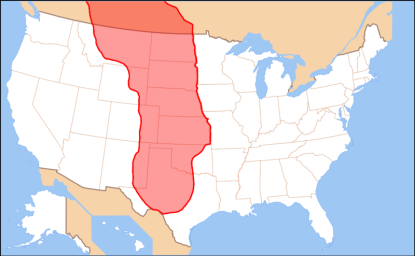
Politically, this area, even the Midlands section, is staunchly conservative. Indeed, it is this area where conscientiousness appears to peak. Much of this area, especially the Midlands section, does appear to be heavily German. Yet it is thoroughly red. Indeed, as we saw in my earlier post Rural White Liberals – a Key to Understanding the Political Divide, I noted that the Plains are the area where Steve Sailer’s “affordable family formation” theory appears to work best: the effective cost of living is low and political conservatism is high. I believe two sorting events might explain this.
First, the area seems to be a region where there was a distinct religious element to settlement. Several religious movements seem to have progressed through here (as seen previously in my post Religions of the American Nations), particularly the Methodists and the Restoration Movement Christians:
These movements may have followed settlement along the Santa Fe Trail, (as pointed out to me by an observant commenter), perhaps populating the area with staunch religious/conservative types. This, coupled with a pocket of devout Lutheranism farther north in the Scandinavian zone combine to leave the Great Plains one of the most religious areas of the country (maps from Valpo):
However, this is only one factor explaining the deep political red of the Great Plains. The personality data point to another factor, which reflects a key event the area’s history: the flight from the area during the Dust Bowl. Since 1920, the area lost a third of its population, and the population continues to decline to this day. However, the Plains has some of the highest White fertility rates in the country. Perhaps this process represents a “boiling off” type scenario that Cochran & Harpending have described for the Amish. The more “open” folks left and continue to do so, heading west and east to places more suited to their proclivities. This would have served to concentrate the religious and conservative character of the region.
Edit, 6/10/14: [**Indeed, I have tracked down a map that shows when each county in the nation ceased growing in population (from here):
As we can see, the vast area of the Great Plains, as well as areas to the east in Greater Appalachia and the Midlands, have been losing people since the beginning of the 20th century. Many of these people went west to the Far West and the Left Coast. If we imagine that this represented a sustained loss of people with a certain cognitive profile – as seen from the fact that this area is depleted in individuals open to experience and introverted – then the conservative bent of the area makes more sense. Indeed, even the more eastern section of the Midlands may be more conservative than it once was thanks to this sustained out-migration. **]
Sorting has been key to the genesis of the Far West. The obligatorily pastoral living favored the Scots-Irish from Greater Appalachia to settle the region, and the distance, isolation, and harsh climate (and hostile Native Americans trying to resist the conquest of their territory) selected for an individualistic, tough-minded type of person. There was a reason the West was Wild. This has left a special mark of the personality of the area, as Staffan once discussed:

This is a map of the distribution of “entrepreneurial” personality type (from Obschonka et al, 2013). As we see, it clearly peaks in the Far West (as does entrepreneurial activity). This is interesting evident on the ABC show Shark Tank, a reality show were budding entrepreneurs seek investment from a panel of venture capitalists. The Far West, despite being the least populated of the American nations, seems to produce more than its fair share of entrepreneurs on the show.
Despite its relative conservatism, women have long held a high place in Far Western society. The harsh environment favored wives that were competent full partners to their husbands. That is, when men could find wives. Women were often in short supply, and subsequently become highly valued. Indeed, the lack of women created a huge demand for prostitution, and this allowed prospecting women to capitalize on this as brothel madams, many managing to become quite wealthy. These madams were actually key to building important parts of Far Western society (and it is a Far Western state, Nevada, where prostitution remains legal today). Indeed, the Far West was where women first gain the right to vote, something that was resisted in the Tidewater and the Deep South to the end (from here):

These data and historical events serve to underscore the importance of the character of the people to leading to the character of a nation. Each and every population is unique, and, as the Far West (including the Great Plains), the Left Coast, the French Canadians demonstrate, what begins as one population and one people can produce several quite distinct daughter populations, if they are subjected to strong and ongoing assortment. The character of a nation can be altered permanently if new people move into it, as happened to the many of the northern American nations.
Indeed, this brings me back to the whole topic of “assimilation.” It is largely considered a given in today’s society that immigrants eventually “assimilate” into their new home societies and even adopt the customs of their new lands. This is a canard. As I said, assimilation generally doesn’t happen. Rather, people have mistaken the adoption of things like language (which, as Judith Rich Harris demonstrated, is heavily dependent on childhood peer groups) to be evidence that immigrants adopt the behaviors of their hosts group in everything else. A little closer inspection can show that that plainly does not happen. Indeed, is the New England of today the same as the New England of the Civil War era before the Irish, Italians, French, and Portuguese came? M.G. gave a detailed answer to that question. She noted the higher crime rates and higher levels of endemic corruption among the Catholic Irish, Italians, and other immigrant groups. Some of this likely abated over time as the least successful individuals returned home. However, today, we see in areas across the North where these clannish groups have settled, corruption remains a serious problem (map of political corruption conviction rates per 100,000 population – which likely woefully underestimates the true incidence of corruption because it doesn’t catch “legal” corruption nor offenders who don’t get caught, from here):

The general non-existence of assimilation is further elucidated when one looks at the performance of certain long-resident groups. Here, we can look at the core of the oldest American nation, El Norte. The core of this nation, New Mexico, is one place that is still home to a large fraction of nortenos, including descendants of White Spaniard colonists. There are 7th generation “Hispanics” here. And, as Greg Cochran (here and here) and Chuck have analyzed, these Hisapnics have not converged with the broader White American mean. As Cochran put it:
in a fair-sized data set (1576 people) collected in 1965 … The original respondents and their adult children were interviewed. It shows quite clearly that although second-generation Mexican-Americans averaged more education and higher SES than the first generation, presumably because they knew English, there was no further improvement in the third and fourth generations. The gap remained substantial: the fourth generation had a college completion rate of 6%, compared to a rate of 35% for whites of that same era.
Which is pretty much what you see in New Mexico too, except that here we’re often talking about the fifth, sixth, and seventh generation living in the US
T. Greer once commented on the matter of assimilation for long-time Asian immigrants (not as much as you think – From Foreigners to Countrymen: How Many Generations Until Immigrants Think Like the Rest of Us?). (There is some discussion about possible IQ & educational convergence of 3rd+ generation Asian Americans, but it’s far from clear that a such finding is reliable).
As another example, the case of the Finnish-Americans of Michigan’s Upper Peninsula:
Tourists to the remote towns of the Upper Peninsula (UP) of Michigan may be puzzled by the many Finnish flags adorning local businesses and homes. Evidence of Finnish culture and ancestral pride is ubiquitous in Michigan, which is less surprising when taking into account that Michigan is home to more Finnish Americans than any other state
…
Most of these Finnish settlers arrived on American soil during the “Great Finnish Immigration.” Between 1870 and 1929 an estimated 350,000 Finnish immigrants arrived in the United States, many of them settling in an area that would be come to known as the “Sauna Belt”….
…
The geography of Finland and Michigan, especially the Upper Peninsula, are uncannily similar.
…
With such a high proportion of Finnish Americans in the Upper Peninsula of Michigan, it is no wonder that even today Finnish culture is so intricately intertwined with the UP.
The word “Yooper” means several things to the people of Michigan. For one, a Yooper is a colloquial name for someone the Upper Peninsula (derived the acronym “UP”). Yooper is also a linguistic dialect found in the Upper Peninsula of Michigan that is heavily influenced by Finnish due to the masses of Finnish immigrants who settled in Copper Country.
…
Generations later many of their descendants remain in this peninsula that looks eerily like their motherland; Finnish culture is still a very strong influence in the UP.
Today these Finnish-Americans appear to be generally more Left-leaning, much like their cousins across the Atlantic.
Staffan gives us perhaps the most biting example of the general non-existence of assimilation (emphasis added):
My favorite example of assimilation is southern Sweden, called Scania. It was taken from Denmark 1658, and they still behave as Danes, more ballsy and politically incorrect, more into visual and performing arts etc. Many even want to belong to Denmark and have a referendum about it. And that’s after living in Sweden for 356 years. That’s between two similar countries who have no special ethnic or religious conflicts, disputes over natural resources or anything of that sort.
As I said, many processes can give the false appearance of assimilation over time. Language acquisition and the attainment of skills and education in subsequent generations can give the impression that the newcomers are completely leaving their homeland behind. As well, we have seen the importance of sorting. Immigration is a heavily selective process. At the very least, it selects for a desire (or at least a willingness) to leave home and enter a foreign land. Over and beyond this, it may select for ability, either positively (usually, as we see with modern African immigrants) or negatively, as we see with the New French. Since many immigrants often ultimately return home, retention imposes another selective sieve. And finally, personal taste is a factor. This aspect was involved in the genesis of the Left Coast. Indeed, self-assortment maintains the character of each of American nations, as people born in one nation more suited to the ways of another often find themselves there. This process is just as important for immigrants from overseas as well. To give you an example, I will use myself. I live in Maine – but I am not a Yankee. Though I have ancestry from the British Isles, none of it (as far as I know) is Puritan. Yet here I am. Indeed, before this, I lived for many years in rural eastern Connecticut. While I enjoy visiting New York, I have long since found the New England way of life more to my liking. Many others have similar experiences.
As we’ve seen previously in my post The Son Becomes the Father, twin and adoption studies have established that the heritability of political attitudes, religiosity, and personality are all very high… …and are not measurably impacted by the environment – including the things one things should matter like one’s surroundings. Indeed, the heritability of political orientation approaches 100% when one accounts for measurement error. Political beliefs respond to local circumstances, each person’s behavior adjusting to the landscape of the day. This explains rapid secular trends, as detailed in my post Why HBD. But the fundamental make-up of people doesn’t change – they just respond accordingly to the shifting reality of the day.
…and are not measurably impacted by the environment – including the things one things should matter like one’s surroundings. Indeed, the heritability of political orientation approaches 100% when one accounts for measurement error. Political beliefs respond to local circumstances, each person’s behavior adjusting to the landscape of the day. This explains rapid secular trends, as detailed in my post Why HBD. But the fundamental make-up of people doesn’t change – they just respond accordingly to the shifting reality of the day.
As attitudes and views are so heritable, and verifiable environmental impacts have been hard to turn up, it is clear that the differences we see between all these groups – between groups originating from the same country – have genetic underpinnings. No two human populations are genetically identical, and indeed, the “four British folkways” of David Hackett Fischer are evident in the genetic data (via Razib Khan):


Each human population is unique (indeed, each is composed of unique individuals). While each population exhibits great similarity to related groups (similarity broadly mediated by the degree of relatedness), small but highly significant differences can make all the difference in the world depending on the situation. This was the case with the enduring struggle between two English groups: the Puritans and the Cavaliers. This struggle lives on in Britain’s daughter country, the United States, each side now joined and energized by allies – settlers that have come from across Europe and the world.
This is hardly unique; indeed, the current turmoil in Ukraine should make that unquestionably obvious:

I’ve got your assimilation right here (source)

Eastern Ukraine was settled by Russians – immigrants – who have maintained their identity despite being in the area in since the 16th century in some cases. Today, these two highly related populations, Ukrainians and Russians (both East Slavs) maintain distinct differences, differences that fuel the current turmoil.
But we see similar divisions within countries elsewhere: between England and Scotland; within Spain; within Germany (see my post Germania’s Seed?); and within Italy.
The American nations will outlive us all.
These genetic rifts, within races, even within ethnic groups serve to counter an oft-cited nonsense charge leveled with the release of Nicholas Wade’s A Troublesome Inheritance: that human group differences can’t have any genetic basis because we see differences within groups – as if that fact weakens the case. Indeed, if anything, it serves to show the power of heredity, and absolute insanity of most of these critical claims. To be sure, I will resume addressing this nonsense shortly, but I sure hope this post serves as a potent illustration of human group differences.
Please, if you haven’t seen it, and are new to this topic, see my page:
JayMan’s Race, Inheritance, and IQ F.A.Q. (F.R.B.)
For the theme for the post, I once again use the French song “La Terre Tremblante” from the film In the Electric Mist (see my earlier post Acadie), about the plight of the Acadian-derived Cajuns of Louisiana. This is the version of the song used in the film. The American country influence makes this a fitting theme for this post:
40 Comments
Leave a CommentTrackbacks
- Stop Saying North and South Koreans Are Necessarily Completely Identical Populations | JayMan's Blog
- linkfest: 05/27/14 | hbd* chick
- Key Updates to Posts and Random Notes | JayMan's Blog
- Guns & Violence, Again… | JayMan's Blog
- The Derb on the JayMan | JayMan's Blog
- Maps of the American Nations | JayMan's Blog
- the american revolutions | hbd* chick
- The Myth of the Expanding Circle or You Can’t Learn How to Be an English Vegetarian | Staffan's Personality Blog
- Another Map of the American Nations: School Corporal Punishment | JayMan's Blog
- Outside in - Involvements with reality » Blog Archive » Ultra-Calvinism
- Demography is Destiny, American Nations Edition | JayMan's Blog
- Atlantis versus Hyperborea » The New International Outlook
- slatestarscratchpad heavilyarmedvirtue slatestarscratchpad heavilyarmedvirtue It’s time to introduce… | moridinamael's notes
- Rebel Yell 116: The Reactivity Place, Nick B. Steves – TRS Confederates
- Brain Gain and Brain Drain – The Heresiarch
- American Nations | School Posts
- British Genetics in Detail – Elfnonationalist
- Jayman’s HBD Reading List | Propertarianism
- GUIDE: the best place to buy land for homesteading



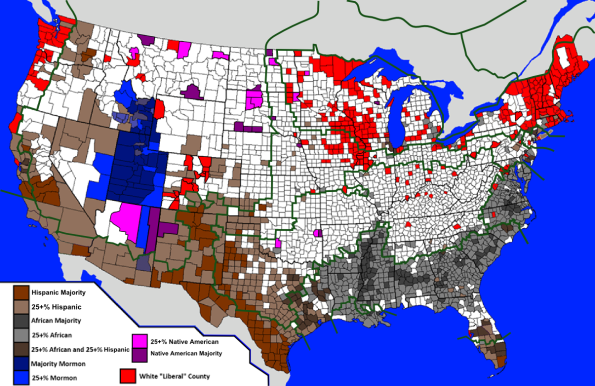



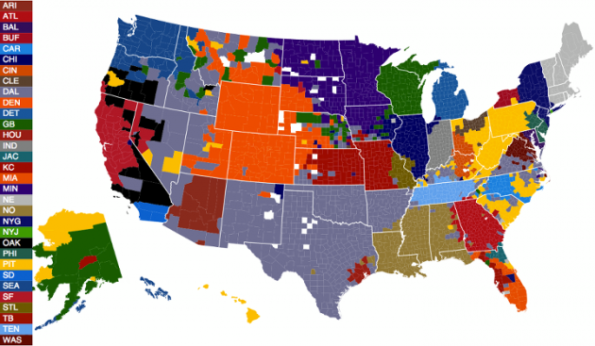








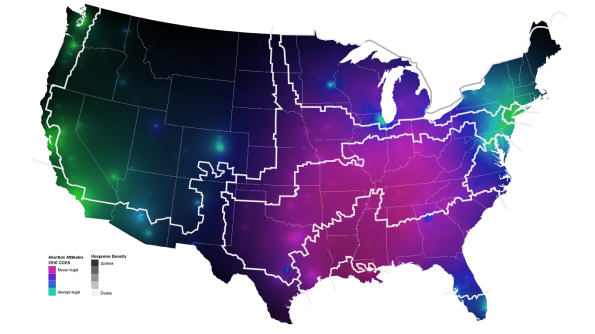
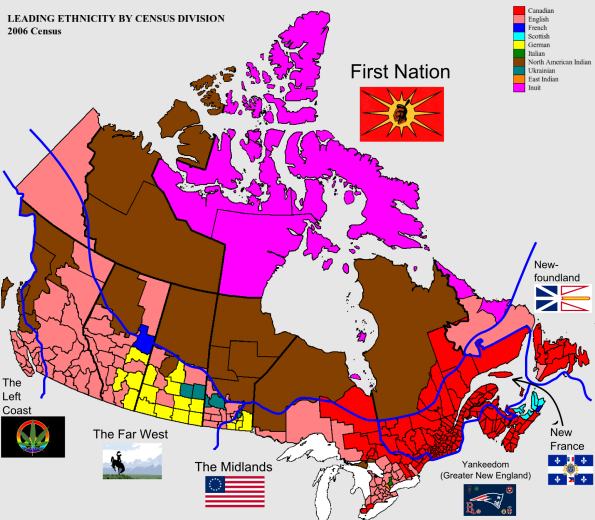








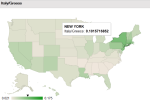


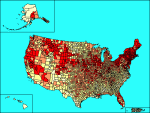
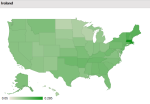





























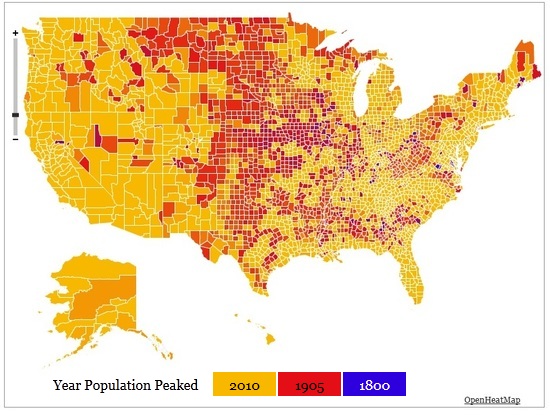
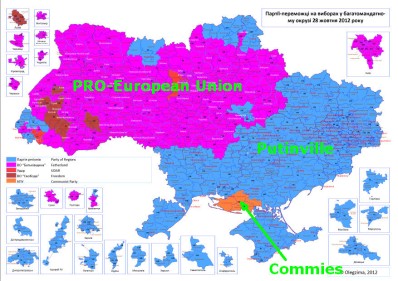






Jay, in your (fabulous) analyses of the “American Nations” you overlook an interesting dimension of US history and genome: the Forest Finns of the 17th century in the mid-Atlantic. They came to be known as the Delaware Finns, and one reason you probably haven’t heard of them is that they were lumped in with their imperial absorbers in Sweden and recorded as Swedes, not Finns, in colonial records in New Sweden and later under Dutch and English rule.
But in local records of the time, they were very much recognized as Finns, and as extremely different from the more agricultural/urbanized Swedes in New Sweden, and later Dutch and English. They manifested the close-in breeding of pre-postmodern Finns, and were recorded by the Dutch, British, French, and others as incredibly robust, fecund, self-sufficient, feisty, wicked smart, slightly spooky/dangerous, outstanding toolmakers, and in cahoots with the Lenni Lenape (local “Indians”).
It was on this pre-existing loom that the English wove their colonial presence.
Their (our) origins: between 1638 and 1656 a small but coherent and ultimately impactful migration of metsasuomalaiset proceeded from upper middle Sweden (mostly Varmland and Dalarna counties), of these indigenous Finno-Ugric people from today’s Eastern Finland (Savo and Karjala provinces) who had previously been removed from their forestlands where they practiced huuhta (swidden) agriculture. Those lands were wanted by Swedish royalty for manufacture of charcoal for use by the burgeoning steel and arms industries. Also around that time, Finns were fighting as mercenary cavalrymen in the Thirty Years’ War, and Sweden was beginning to persecute and outlaw as witches menfolk who practiced the older animist/pagan/song-and-drumming-based religion.
These several hundreds of metsas located to the Delaware Valley, became extremely successful farmers and pioneers, some intermarried with Swedes and a few Dutch and English (and others), and many radiated out from there, particularly after “The Quaker Invasion” of the 1680s. Most of them stayed close in in Pennsylvania, Delaware, New Jersey, and Maryland, and “close in” is relative given that these Finns engaged in the “long hunt” tradition that could take them far away on boat-and-portage hunting, trapping, fishing, and gathering expeditions.
A significant movement of them proceeded into the Appalachians and then farther west still. In PA/NJ they were among the American Revolutionaries (including ancestors of mine), and in fact Finns had been agitating for the colonies’ independence from Europe back into the 1600s.
You might enjoy the late Terry Jordan’s and Matti Kaups’s book on the topic, The American Backwoods Frontier. Jordan (a geographer at UT-Austin) long argued that there is a coherent, westward flowing complex of material culture evidence for Forest Finns being the only eastern seaboard colonial people from the Old World who were genetically and culturally pre-adapted to enter and open a largely forested new continent.
http://books.google.com/books/about/The_American_backwoods_frontier.html?id=3x8MAAAAYAAJ
If you drop me a line, I can share more and connect you with fairly extensive resources. It might be an interesting line of inquiry for you. It’s not certain how many Americans can trace ancestry to these people, but it’s surely in the millions…and those of us who were still in the valley in the 1980s had quite coherent lineages. I come from an unbroken paternal line going back ten generations, so I also inherited a bunch of stories that didn’t make much sense till I learned in the past decade just how coherent this migration and its people were. Thank you for taking the time to read this.
Tikka
The North Korea regime collapses tomorrow and there’s miraculously no civil war or humanitarian crisis. The two countries begin a long and painful process of reunification, like East/West Germany on crack. ~70 years of despotic Communism and famine have left their mark on North Korean culture and even their bodies (Norkies are several inches shorter than their Southern cousins), but what about genes? Are 3-4 generations of zero introgression and (possibly) insane selection pressures on conformity enough to make Northerners notably genetically distinct from Southerners? How might this impact re-integration?
“Today these Finnish-Americans appear to be generally more Left-leaning, much like their cousins across the Atlantic.”
Actually, much of the Finnish-American population descends from leftists who left Finland because of anti-left persecution. Tons of socialists moved to the United States (and other countries of the Americas) because they allowed greater freedom for socialist movements than either the Tsarist empire or newly independent Finland which up to the 1930s was extremely hostile to anything even remotely left-wing. (Long story short, independence was followed by a left-wing coup, a Civil War which the left lost and tens of thousands of Reds died in the White revenge terror. After the Civil War the victors were extremely hostile to the left and large numbers of Red Finns moved to the US to “build socialism” there when even mentioning socialism in Finland could get you beaten up.)
There was also mass migration of Finns from the US to the Soviet Union between the world wars:
https://www.google.fi/search?q=karelia+fever
It ended badly and that also ended much of the right/left hostility in Finland, the left stopped being pro-Soviet after all those massacres right over the border. Finland has a really bizarre history after WWII which has left us with a really unusual society where we’re much more right-wing than, say, Swedes but we’ve gone even further with the Swedish social democratic model because of Soviet pressures. It’s unraveling now and the left has been slowly collapsing since the USSR fell.
The link to 3rd gen Asian-American IQ is broken, the correct URL is http://pseudoerasmus.com/2014/05/21/economic-growth-human-biodiversity/comment-page-1/#comment-19 .
Wow, one of the longest Jayman’s posts since ages. Very interesting read, in addition.
My apologies for being off topic, but I found a document online that may interest you. I came across it while searching for “behavioral genetics phrenology,” because after first coming across (a couple of months ago) b.g. being called phrenology I have seen it several more times. So, here is the RationalWiki (as in, I suppose, anyone who does not agree is irrational) entry on Biological Determinism. It is a sort of compendium of the sorts of things that your and related blogs seem to be struggling against. It may be useful as specimen collection, or just entertaining. In the past I have considered writing a parody document along this line, but I have been summarily preempted. I am sending a similar/identical comment to several other blogs, this is too good not to share.
http://rationalwiki.org/wiki/Biological_determinism
Jayman, on the map of counties where Obama got less than 20% of the white vote, four of the five Illinois counties are counties with large state prisons. I wonder if Edison Research got confused when looking at the counties demographics. For example, Logan County gave 33% of its vote to Obama. Its largest city is 93% non-Hispanic white & other than the state prisons, the remainder of the county is surely far whiter than the 93% non-Hispanic white county seat. Yet because of the two state prisons, the Census Bureau lists Logan County as 87.7% non-Hispanic white & 11.4% institutionalized.
Woodard tried to say recently that the Democratic trend in tidewater Virginia was due to the “noblesse oblige” of the Virginia Cavaliers. Incredible. I wonder how many more facts he has stretched to accommodate his bullshitted theory.
I was just looking inside Putnam’s book at Amazon. Was struck by how he quickly moves from brief description of old urban centers made up mostly of white ethnic (Irish, Ukrainians, Jews,etc.) neighborhoods to the the displacement of those same ethnic groups to “homogeneous” white suburbs. Funny how you can lose your ethnicity by moving a few miles. Putnam may be a sub rosa white nationalist.
Reblogged this on bbbatez and commented:
Maps of American nations. Well done and very interesting look at the political and cultural differences geographically.
@bbbatez:
Thank you!
Your welcome and thank you.
Outstanding. Another post to bookmark for sure, what a rich collection of maps you’ve put together here. I cannot imagine the time this must have taken. This is critical data that is missing from almost all analysis on ‘American’ cultural questions. I have to say that reading ‘Albion’s Seed’ this winter really opened my eyes to so many things. Your series on the American nations is, as far as I can tell, unique in the blogosphere. Chapeau bas, I look forward to reading more.
Good map which shows NE movement across North America.
http://blogs.discovermagazine.com/gnxp/2011/01/the-empires-of-american-english/
@Patrick:
Good find, but those were featured in the antecedent post to this one, Maps of the American Nations.
Add this map! It clearly shows Greater Appalachia. http://www.nytimes.com/2014/06/26/upshot/where-are-the-hardest-places-to-live-in-the-us.html?kwp_0=3747&WT.mc_id=AD-D-E-KEYWEE-SOC-FP-SEPT14NONSALETEST-ROS-0922-1006&WT.mc_ev=click&bicmp=AD&bicmlukp=WT.mc_id&bicmst=1411358400&bicmet=1446872400&kwp_1=83683&kwp_4=26048&_r=0&abt=0002&abg=0#
Notice how the Midlands average between 60-75 percent while the rest of the US except for Louisiana fluxuates wildly. http://www.nytimes.com/2014/08/16/upshot/mapping-migration-in-the-united-states-since-1900.html?kwp_0=4035&WT.mc_id=AD-D-E-KEYWEE-SOC-FP-SEPT14NONSALETEST-ROS-0922-1006&WT.mc_ev=click&bicmp=AD&bicmlukp=WT.mc_id&bicmst=1411358400&bicmet=1446872400
And yet another great climate zone map which you can clearly see most of the American Nations! Not sure why I am so fascinated about this but I am! http://commons.wikimedia.org/wiki/File:North-America_Koppen_Map.png
Virginia has one of the lowest crime rates and the country. Maryland and North Carolina have higher crime rates however adding to the tidewater nations violent culture.
You also said that the tidewater area was fiercely against abortion when the majority of it was a mild blue and parts of it bright green. All of Appalachia and the Deep South were pink. None of tidewater was.
At one point, it says that both Virginia and Texas have higher than average crime rates but also much higher execution rates.
I know that Texas has a higher than average crime rate and that both states have very high execution rates. However, many sources claim that Virginia has one of the lowest crime rates in the country in part due to its lack of poverty in most areas.
Can you explain how you came to this conclusion?
https://www.usnews.com/news/best-states/slideshows/10-safest-states-in-america